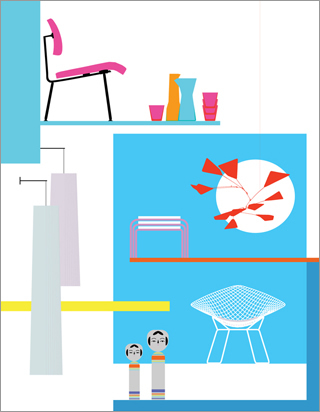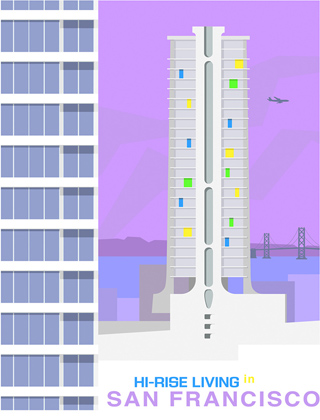Eye for the Fantastic - Page 2
 |
|
|
"It was interesting that Michael identified it as a piece of modern architecture, too," says Kiernat, whose firm, Page & Turnbull, had evaluated the building's historic worth—and found it worthy.
She quickly became a Murphy fan.
 |
 |
|
|
"I think they really appeal to architects because they are so architectural," Kiernat says of Murphy's prints. "He takes a building and breaks it down to its essential features, its essential forms. He uses color really well, and there's always something whimsical—an airplane flying by, or a view, a view of the Golden Gate Bridge."
Another fan is Gretchen Hilyard, president of the Northern California chapter of Docomomo, a group of architects and architectural historians that celebrates modernism.
"I was excited about his work," she says. "For us, not a lot of people are drawing attention to this stuff, especially from an artist's perspective."
"What he does is really unique," she says. "He's kind of made architectural drafting artistic."
Thanks to Kiernat, who was president of the San Francisco chapter of the American Institute of Architects, and Hilyard, Murphy was soon showing his 'Forgotten Modernism' series of San Francisco prints at the AIA Gallery on Sutter Street, focusing on what Murphy calls San Francisco's "often overlooked…rich catalog of modern architecture." The exhibit was co-sponsored by Docomomo.
The exhibit has led to another promising gig, Murphy says—creating an image of the San Francisco Museum of Modern Art. The museum is expected to use the image on posters, perhaps cups, perhaps a T-shirt.
Murphy's 'Forgotten Modernism' subjects range from the iconic (the Embarcadero Center) to the well known (Eichler's Summit tower on Russian Hill) to the lesser known, including a group of 'Painted Ladies'—but modern houses, of course, not Victorians. He's also done images from further afield, including Palm Springs and Los Angeles airport's Theme Building.
He's also done an image of one traditional Victorian Painted Lady, the Haas-Lilienthal House, for San Francisco Architectural Heritage, the house's owner.
So far at least, Murphy hasn't produced images of any buildings that have been torn down—though some have been heavily altered in ways that his prints don't show. One, the old Jack Tar Hotel, a jazzy, colorful image, is slated to make way for a hospital. The North Beach Library is also destined for demolition.
Murphy says he is an artist, not a preservation activist. "My agenda is to show people, 'Look at this fantastic building that's still here.' It's not saying, 'Look at this fantastic building that's still here that's going to be torn down. We should do something about it.'"
It's easy to see the inspiration behind Murphy's art. It is, after all, an art that plays up its roots, starting with the 1950s and 1960s travel posters that he collects, from the days when flying was romantic, and stewardesses—they weren't called 'flight attendants' back then—were all shapely and sprightly and young.
He talked architecture with colleagues in a bar near the San Francisco Museum of Modern Art, worked for some of them, and freelanced. After a while, he was doing okay.
"So what do I do? I move to Ireland."




